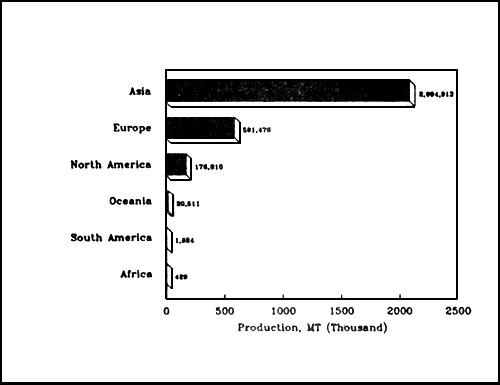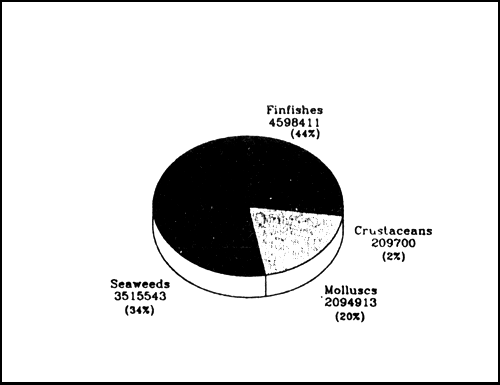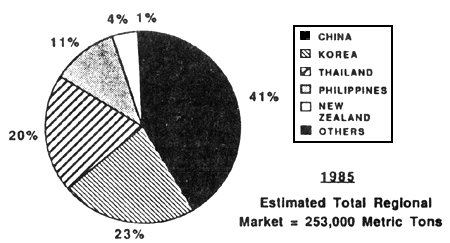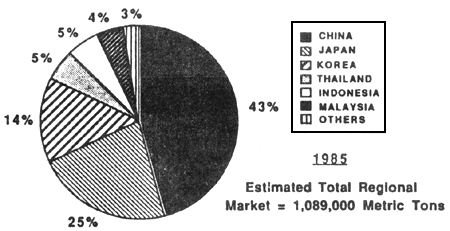BIVALVE FARMING: AN ALTERNATIVE ECONOMIC ACTIVITY FOR
SMALL-SCALE COASTAL FISHERMEN IN THE ASEAN REGION
by
Medina N. Delmendo1
Most countries in the ASEAN region are faced with the problem of uplifting the socio-economic conditions of small-scale coastal fishermen. This problem has become more serious as a result of dwindling catches from coastal fisheries resources. The rapid population growth in coastal communities has all the more exerted increasing pressure on the productivity of these resources as fishing effort from the artisanal fishing sector has been increasing.
A strategy which some developing countries could undertake to find alternative economic activities for small-scale fisher-men would be in bivalve farming such as oysters and mussels. These molluscs are easy to farm; they are nutritious food items and with proper management and direction of bivalve farming development programmes, the product could be a source of foreign exchange.
The world mollusc production amounted to 4.4 million metric tons in 1985 of which about 2.9 million MT or 65.6 percent were produced from aquaculture (Figure 1). Asia contributed about 72.5 percent of the total while the rest came from Europe, North America, Oceania, South America and Africa (Figure 2). Of the total aquaculture production in Asia, molluscs contribute 20 percent (Figure 3). The major mollusc-pro-ducing countries in the ASEAN region are Japan, Korea and China (Table 1).
Among the ASEAN countries, the Philippines is the major mollusc producer where the growth rate over a 4-year period was 131.6 percent (1980–1984). Oysters made up 55 percent of the country's total mollusc production. Malaysia devotes mainly to cockle farming while Thailand produces more mussels than oysters. Singapore was highly successful in mussel farming but the price and marketability of the product was not that good to encourage fishermen to expand farming operations.

Figure 1. World mollusc landings from capture and culture fisheries in 1985
(Source: Lovatelli, 1989)

Figure 2. Mollusc aquaculture production by continent in 1985
(Source: Lovatelli, 1989)

Figure 3. Aquaculture production in Asia in 1985 of the major resource groups
(Source: Lovatelli, 1989)
Among the species of bivalves cultured and harvested from the wild in the region include the oysters, cockles and mussels. Of the species of oysters belonging to Ostreidae, the Crassostrea and Saccrostrea predominate. Oysters of commercial importance belonging to Crassostrea include C. rivularis, C. gigas and C. plicatula, which are widely cultured in Japan, Republic of Korea and China. The subtropical and tropical species of oysters include C. belcheri, C. echinata, C. eredalei, C. lugubris, C. madrasensis, Saccrostrea cucullata and Ostrea folium.
Oysters are very nutritious. It also contains a high level of glycogen which makes an excellent source of energy that reduces the work load of the pancreas of the human body. Complex sugars in the bloodstream must be broken down into glycogen by enzymes which the pancreas secretes before these are stored in the liver. Glycogen pro-vided from oysters will reduce the work load of the pancreas (Yamaha Fishery Journal No. 28, 1989). The nutritional content per 100 g portion of oyster compared to other food items is in Table 2.
Oysters are a gourmet and luxury food in developed countries. On the other hand, in developing countries such as the Philippines, it is a cheap food but increased demand for local consumption is constrained by poor quality due to the fact that oyster farms are located in shallow coastal areas contaminated with domestic wastes. As such, the consuming public is wary of eating oysters too often. The Philippines cannot meet the export quality standards required by importing countries for this reason. Oyster and mussel farming is already a viable economic activity in the country despite very traditional techniques used in general.
Table 1. Total production of molluscs
Unit: 1 000 metric tons
| Annual values | Average annual growth rate (%) | ||||||
| Country/region | 1975 | 1981 | 1982 | 1983 | 1984 | 1975–84 | 1980–84 |
| Australia | 9.2 | 8.2 | 8.2 | 8.2 | 8.2 | -1.6 | -0.0 |
| China | 248.9 | 301.6 | 343.4 | 309.1 | 372.6 | -8.0 | 7.8 |
| Hong Kong (U.K.) | 0.1 | 0.2 | 0.2 | 0.1 | 0.1 | -5.8 | -18.8 |
| India | 0.1 | 1.8 | 1.8 | 4.0 | 4.0 | 81.4 | 27.1 |
| Japan | 278.0 | 302.0 | 335.2 | 347.1 | 341.7 | 4.4 | 3.5 |
| Korea, Republic of | 189.5 | 317.8 | 281.0 | 289.4 | 282.8 | 5.7 | -0.9 |
| Malaysia | 53.5 | 121.3 | 121.3 | 49.4 | 49.4 | -8.5 | -23.6 |
| Philippines | - | 12.8 | 25.3 | 29.8 | 34.9 | 131.6 | 131.6 |
| Taiwan (Province of China) | 30.9 | 44.7 | 46.2 | 53.7 | 59.2 | 13.1 | 11.2 |
| Thailand | 23.0 | 53.7 | 23.9 | 29.8 | 29.8 | -2.7 | -14.4 |
| New Zealand | 0.9 | 5.0 | 5.0 | 7.1 | 7.1 | 38.4 | 11.1 |
| Asia-Pacific Total | 834.1 | 1 169.1 | 1 191.5 | 1 127.7 | 1 189.8 | 5.7 | 1.7 |
| Rest of world | 554.1 | 659.1 | |||||
| World | 1 388.2 | 1 786.8 | |||||
Source: Csavas, 1985
Table 2. Comparison of nutritional contents (per 100 g portion)
| Minerals (mg) | Vitamins | |||||||||
| Food | Energy | Protein | Fat | Sugar | Calcium | Iron | A | B1 | B2 | C |
| (Kcal) | (g) | (g) | (g) | (IU) | (mg) | (mg) | (mg) | |||
| Oyster raw | 78 | 9.7 | 1.8 | 5.0 | 55 | 3.6 | 55 | 0.16 | 0.32 | 4 |
| Eggs | 162 | 12.3 | 11.2 | 0.9 | 55 | 1.8 | 640 | 0.08 | 0.48 | 0 |
| Milk | 59 | 2.9 | 3.2 | 4.5 | 100 | 0.1 | 110 | 0.03 | 0.15 | Ø |
Source: Revised Standard Nutritional Contents List of Japanese Foodstuffs
The Philippines ranked 8th among the top 10 oyster producers in the world while Thailand ranked 12th. The major oyster producers are the United States, Japan, Korea and France as shown in Table 3 (Chew, 1989).
Table 3. Oyster production for several lead countries (total worldwide market = 1 101 000 metric tons, 1985)
| Country | Production × 1 000 mt | World market (%) |
| United States | 260.4 | 23.6 |
| Korea | 254.5 | 23.1 |
| Japan | 251.2 | 22.8 |
| France | 139.8 | 12.7 |
| China | 45.0* | 4.1* |
| Mexico | 42.7 | 3.9 |
| Taiwan | 25.5 | 2.3 |
| Phillipines | 15.5 | 1.4 |
| New Zealand | 10.8 | 0.9 |
| Australia | 7.9 | 0.7 |
| Canada | 4.7 | 0.4 |
| Thailand | 4.5 | 0.4 |
Source: Chew, K., 1989
The green mussel Perna viridis is cultured in the ASEAN region, particularly in Thailand, Singapore and Philippines. Thailand ranked 7th and the Philippines 8th in the world production of mussels (Table 4).
Table 4. Mussel production for several lead countries (total worldwide market = 713 000 metric tons, 1985)
| Country | Production × 1 000 mt | World market (%) |
| Netherlands | 116.2 | 16.3 |
| Spain | 103.2 | 14.5 |
| China | 101.0 | 14.2 |
| Denmark | 74.7 | 10.5 |
| France | 54.9 | 7.7 |
| Korea | 54.4 | 7.7 |
| Thailand | 49.5 | 6.9 |
| Philippines | 26.2 | 3.7 |
| West Germany | 20.8 | 2.9 |
| Chile | 17.0 | 2.4 |
| United States | 15.7 | 2.2 |
| Italy | 10.9 | 1.5 |
Source: Chew, K., 1989
For the mussel producers in Asian and Oceania region, the estimate shares of two ASEAN countries in the production of mussels, despite the extensive methods employed is quite substantial as shown in Figure 4.

Figure 4. Approximate share of mussel production for major producing countries of Asia and Oceania (Source: Chew, 1989)
Cockles, clams and arkshells are other bivalves which are widely cultured in the ASEAN region. The most common species of cockles are Anadara granosa and Arca. Thailand, Indonesia, Malaysia and Philippines are among the lead producers of these bivalves, particularly the cockles (Figure 5 and Table 5).

Figure 5. Approximate share of clam, cockle and arkshell production for major producing countries of Asia (Source: Chew, 1989)
Table 5. Catches of combined clams, cockles and arkshells for several lead countries in Asia (In Thousand of metric tons, 1975 to 1985)
| Country | 1975 | 1977 | 1979 | 1981 | 1983 | 1985 |
| China | 225.3 | 288.8 | 217.6 | 269.2 | 367.4 | 473.0 |
| Japan | 233.8 | 288.1 | 264.2 | 152.4 | 241.3 | 277.6 |
| Korea | 86.0 | 92.9 | 81.9 | 105.0 | 97.6 | 147.3 |
| Thailand | 20.7 | 34.1 | 21.8 | 85.6 | 48.4 | 54.0 |
| Indonesia | 2.5 | 34.0 | 34.7 | 39.5 | 45.8 | 53.5 |
| Malaysia | 29.2 | 46.4 | 63.4 | 68.9 | 42.4 | 46.8 |
| Taiwan | 17.0 | 21.6 | 20.0 | 23.6 | 27.5 | 30.0 |
| Philippines | 2.9 | 3.0 | 4.2 | 3.7 | 4.7 | 2.3 |
| Species: | |
| China | Bivalvia |
| Japan | Anadara subcrenata, Mactra sachalinensis, Meretrix lusoria and Venerupis japonica |
| Korea | Arca spp, Anadara granosa, Cardiidae, Mactra sachalinensis, Meretrix lusoria and Venerupis japonica |
| Thailand | Anadara granosa and Paphia spp |
| Indonesia | Anadara spp and Meretrix spp |
| Malaysia | Anadara granosa and Paphia spp |
| Taiwan | Anadara spp, Corbicula spp and Meretrix spp |
| Philippines | Anadara spp and Paphia spp |
Source: Chew, K., 1989
While molluscs, particularly oysters, cockles and mussels are easy to farm compared to finfish and shrimps, their cultivation techniques have not improved much from traditional methods in the developing countries. Mollusc culture is not capitalintensive; the species use natural food and does not pollute the environment. All molluscs seeds are obtained from natural grounds.